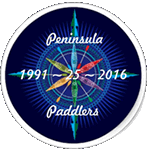What type of kayaking is right for you?
Our club promotes Recreational Paddling, which is casual paddling, in relatively calm water such as ponds, flat water rivers, and large and small lakes. Many club paddlers also use their recreational kayaks for fishing or photography. If social paddling with a group of like-minded enthusiasts is for you, try the Peninsula Paddlers.
What is the right type of kayak for you?
Recreational and light touring kayaks can typically accommodate one or two paddlers: single (1), tandem (2). They typically have larger cockpit openings to make entry and exiting easier; are a wider width (or beam) for stability; usually are less than 12 feet in length making them slower but lighter to lift; have limited cargo capacity; and are made of roto-molded plastics.
Sea kayaks are a good intermediate choice because of the versatility. They’re designed a to be a bit longer with multiple hatches and additional deck tie downs to accommodate safety equipment and more gear necessary for multi-day trips. They’re great for day-trips or overnight camping as they are designed for longer excursions with straighter tracking with their lengths ranging between 12′ and 20′.
How fit should I be?
Paddling fitness is important if you wish to maximize your paddling enjoyment. You may be ready to hop in that kayak, but before paddling, get a smart start. Conditioning your body not only improves your endurance – it helps prevent injuries, sore muscles and strains. If you tend to hibernate in the winter, then you may want to begin to exercise and stretch to condition yourself while waiting for the winter to pass. Try doing some back strengthening, side curls, torso twisting, shoulder strengthening, arm circles, wall push-ups, and forearm/wrist strengthening. By spring you will feel more fit and energetic.
What paddling gear do I need?
Mandatory equipment: PFD, sound signalling device (whistle), navigational light, heaving line or rope, pump or bailer
Optional/suggested equipment: spare paddle, knife, repair kit, float kit, spray skirt, paddle float, sunglasses, hat, sunscreen, spare clothing, small dry bag, paddle leash, GPS, and a PLAN!
Can I have fun and be safe too?
Yes! Form good habits from the start – the time you take to prepare can be the difference between a great kayaking day and a bad experience.
Wear a PFD – it is the number one thing to do!
Find out the current weather and forecasted changes –via the internet at www.weather.com, NOAA weather station, or the local radio station.
Have a float plan – It’s a good habit to let someone on shore or at home know of your plans. Even if intending to simply paddle for a few hours at the nearest pond
Drink water – You will need to carry enough water for each paddler and more in extreme heat. How much? … the rule of thumb is one gallon per day for each paddler.
Wear bright colours – When you buy your kayak and gear, choose bright colors – they double as a visual signal. Consider bright orange – yellow – bright green. Red is not as visible at long distance.Carry a signaling device – always have your signaling device (i.e. whistle, radio, or cell phone) ready and available for any type of emergency
Although some of us have all the extras in kayaking gear, there are items which are mandatory. You are required to have a life jacket, a whistle, a bailer, lights between sundown and sunrise, and a line of 15 m in length. An extra set of clothes in a dry bag is not mandatory, but is recommended. (Especially when the water or weather is cold.) Our club also asks if you would please fill out a personal medical history form (which is on the Peninsula Paddlers Website). Place it into a plastic bag, and attach it to the front hatch cover of your kayak.
HAPPY (AND SAFE) PADDLING!






